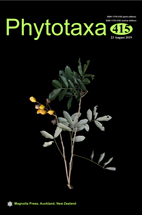Abstract
Centroceras Kützing is a small red algal genus with 18 currently accepted species (Guiry & Guiry 2019), characterized by simple filamentous thalli with erect axes arising from a prostrate system and di-trichotomous branching (Hommersand 1963). The characters used to distinguish species are primarily cortical filament morphology: shape and number of the acropetal cortical cells, shape of gland cells, and shape of spines (Won et al. 2009). The generitype C. clavulatum (C. Agardh) Montagne has been viewed for a long time as a highly variable and cosmopolitan species (Hommersand 1963). Molecular and detailed morphological analyses brought Barros-Barreto et al. (2006) to report that C. clavulatum may consist of a species complex and Won et al. (2009) confirmed this hypothesis identifying eight taxonomic entities phylogenetically segregated from genuine C. clavulatum. Seven of these entities were assigned to the following species: C. gasparrinii (Meneghini) Kützing, C. hommersandii Won, T.O. Cho & Fredericq, C. hyalacanthum Kützing, C. micracanthum Kützing, C. natalensis Won, T.O. Cho & Fredericq, C. rodmanii Won, T.O. Cho & Fredericq, and C. tetrachotomum Won, T.O. Cho & Fredericq, (Won et al. 2009). Centroceras gasparrinii, C. hyalacanthum, and C. micracanthum are three western Atlantic species listed as synonyms of C. clavulatum since the middle of the 19th century and resurrected from the ‘C. clavulatum complex’ by Won et al. (2009). In particular, two of these taxa were described from specimens of the Mediterranean Sea: C. gasparrinii (as Ceramium gasparrinii Meneghini, type locality Palermo, Italy) and C. micracanthum (reported with the synonym Centroceras leptacanthum Kützing, type locality Genoa, Italy). Therefore, the numerous Mediterranean records of C. clavulatum (e.g., Gómez Garreta et al. 2001; Verlaque 2001; Sfriso & Curiel 2007; Taşkýn et al. 2013) most probably belong to one of these two species and have to be re-examined for a correct identification and to understand the spatial distribution of the different taxa (Tsiamis et al. 2010). For this reason, in the last years in Greece (Tsiamis et al. 2010), Spain (Gallardo et al. 2016) and Morocco (Hassoun et al. 2018) accurate sampling and morphological analyses of specimens previously identified as C. clavulatum were conducted to determine their correct taxonomic identities. In all cases the recognized species was C. gasparrinii, which can be distinguished morphologically from the other ones previously known as C. clavulatum by the presence of ovoid gland cells and ovoid terminal acropetal cortical cells (Won et al. 2009). As reported by Tsiamis et al. (2010), Greek samples differed from those described by Won et al. (2009), in the smaller number of periaxial cells (10–12 against 13–19).

